What makes the Philippines unique is its geography. It has an archipelago with 7,641 islands. This impacts the country’s landscape and ecosystem. The Philippines is the world’s fifth largest island country, with a coastline of 36,289 kilometers. It also has an Exclusive Economic Zone of 2,263,816 km2, which is a significant aspect of its archipelago and geography, including islands?
The Philippines has diverse landscapes like beaches, mountains, and forests. This creates a wide range of ecosystems. These ecosystems support a vast array of flora and fauna. The eleven largest islands account for 95% of the total land area. The largest island, Luzon, covers about 105,000 square kilometers. The second-largest island, Mindanao, has an area of about 95,000 square kilometers.
The country’s unique geography supports a wide range of ecosystems. These ecosystems are home to a vast array of flora and fauna. The Philippines is the world’s second-biggest geothermal energy producer. It meets 18% of the country’s electricity needs through geothermal power. The country also has significant copper, palladium, chromite, nickel, and zinc deposits. Despite challenges in tapping into these resources, it is an important aspect of the country’s archipelago and geography.
Key Takeaways
- The Philippines is an archipelago with 7,641 islands, making it one of the world’s largest island groups.
- The total land area of the Philippines is approximately 300,000 square kilometers, with a coastline of 36,289 kilometers.
- The country has a diverse range of landscapes, including beaches, mountains, and forests, creating a wide range of ecosystems.
- The Philippines is the world’s second-biggest geothermal energy producer, meeting 18% of the country’s electricity needs through geothermal power.
- The country has significant copper, palladium, chromite, nickel, and zinc deposits, despite challenges in tapping into these resources.
- The archipelago is positioned in Southeast Asia, bordered by the Pacific Ocean and neighboring countries such as Indonesia, Malaysia, Vietnam, China, Taiwan, and Japan.
Understanding the Archipelago Concept
The concept of an archipelago is closely tied to a country’s geography. The Philippines is a great example of this. Its unique geography, with thousands of islands in the western Pacific, supports a wide range of ecosystems. These ecosystems are home to a vast array of flora and fauna, making the Philippines rich in biodiversity.
An archipelago is a group of islands clustered together. The Philippines is an oceanic archipelago, not connected to a continent. This unique geography has led to a distinct biodiversity. Many species are found only in the Philippines.
The archipelago concept involves attempts by nations like the Philippines and Indonesia to expand their territorial seas and internal waters. This has sparked discussions on geography and biodiversity. The focus is on preserving the unique ecosystems in these islands.
| Country | Type of Archipelago | Biodiversity |
|---|---|---|
| Philippines | Oceanic | High |
| Indonesia | Oceanic | High |
Geographic Location of the Philippine Archipelago
The Philippines is in Southeast Asia, with thousands of islands in the western Pacific Ocean. Its geography supports a wide range of ecosystems. This makes it a favorite spot for travel and nature lovers.
The country is surrounded by the Philippine Sea, South China Sea, and Celebes Sea. It’s also near Indonesia, Malaysia, and Taiwan. This location has enriched the country’s culture and biodiversity.
Some key features of the Philippines include:
- Over 7,100 islands, with Luzon and Mindanao being the largest
- A land area of about 300,000 square kilometers
- A population of over 105 million, with diverse cultures and languages
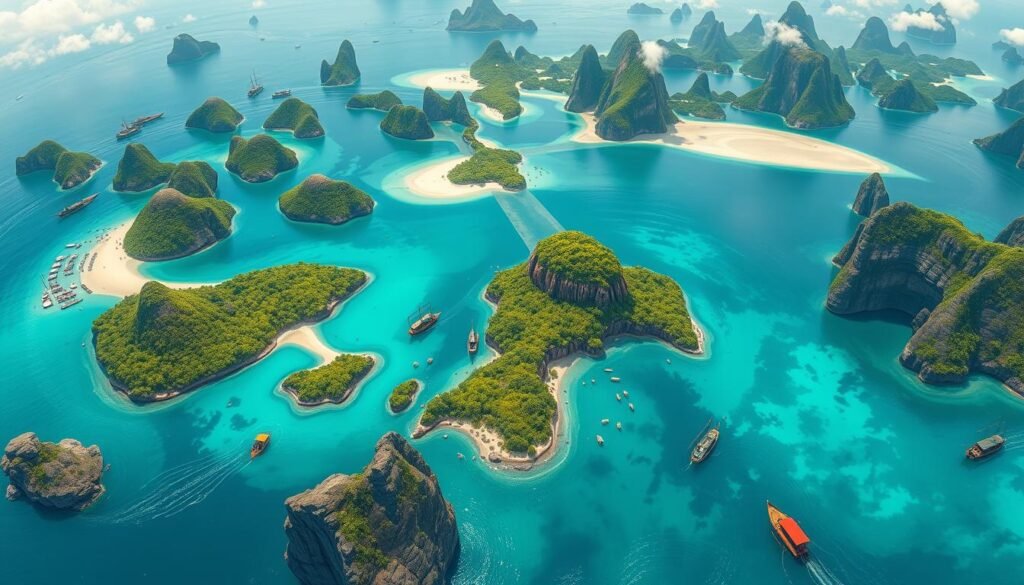
The Philippines is home to many species of plants and animals. Its unique geography and nature make it perfect for travel and exploration.
| Island | Land Area (km²) | Population |
|---|---|---|
| Luzon | 104,688 | 53,336,134 |
| Mindanao | 94,631 | 25,537,691 |
The Number of Islands in the Philippines
The Philippines is an archipelago with 7,641 islands. Its geography supports a wide range of ecosystems. This leads to a rich biodiversity in the islands.
About 2,000 islands are home to people, while most are uninhabited. The Philippines is divided into three main island groups: Luzon, the Visayas, and Mindanao. For more on the Philippines’ history and culture, check out this website about Teresa Magbanua.
The islands in the Philippines are grouped in different ways. For example:
- Luzon, which includes the Babuyan group and the Batanes group
- The Visayas, which has islands like Bohol, Cebu, and Leyte
- Mindanao, the southernmost major island group
The Philippines’ islands are vital for their natural beauty and biodiversity. They also play a big role in the country’s geography and economy. Each island group adds to the country’s identity and helps in its development.
| Island Group | Number of Islands | Population |
|---|---|---|
| Luzon | 1,000 | 53 million |
| Visayas | 2,000 | 20 million |
| Mindanao | 1,000 | 25 million |
The Formation of the Philippine Archipelago
The Philippine Archipelago was shaped by geological forces like plate tectonics and volcanic activity. Its geography has led to diverse ecosystems, home to many plants and animals. The Philippines sits on the Pacific Ring of Fire, known for its volcanic and seismic activity.
Island arcs formed through subduction and eruptions over time. The country’s nature was shaped by the collision of three plates: the Eurasian, Philippine Sea, and Indo-Australian Plates. This complex process has made the Philippines’ biodiversity rich and varied.
Some key facts about the formation of the Philippine Archipelago include:
- The original island arcs in the Philippines are believed to have formed millions of years ago at the southern part of the Philippine Sea Plate.
- The Philippine Sea plate is moving northwest at a rate of 6–8 cm per year towards the Eurasian plate.
- The Palawan Block broke off from the Eurasian plate during the late Eocene.
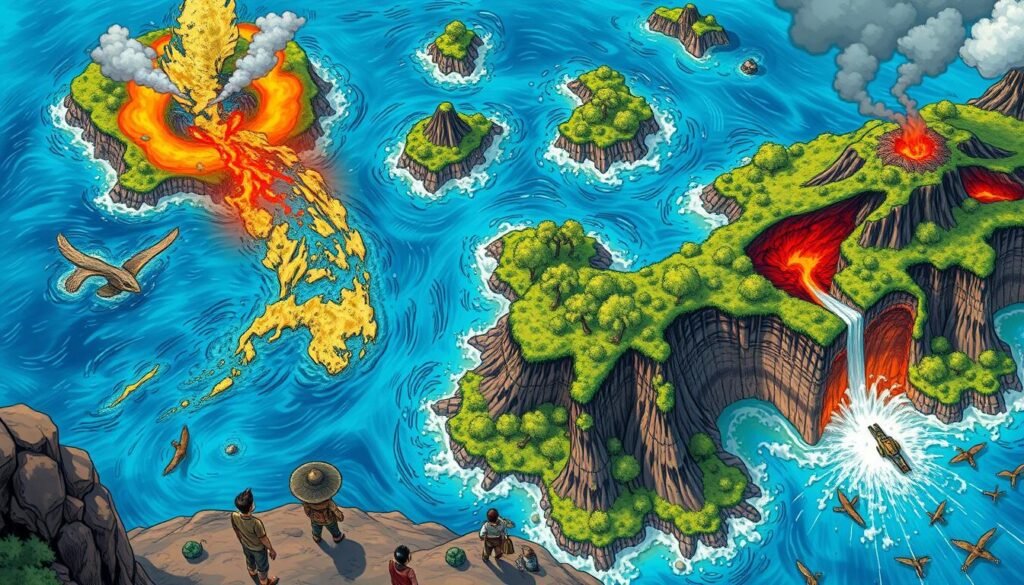
The Philippines’ unique landscapes, from beaches to mountains and forests, were shaped by geological processes. This diversity supports a wide range of ecosystems. These ecosystems are home to many plants and animals, enriching the country’s biodiversity.
| Island | Area (square miles) |
|---|---|
| Luzon | 40,541 |
| Mindanao | 36,680 |
Climate and Weather Patterns in the Philippines
The Philippines is an archipelago with a diverse geography. It has a tropical climate with high temperatures and humidity all year. Being near the equator, it gets a lot of sunlight, making it great for travel and exploring nature.
The Philippines has five climate types: tropical rainforest, tropical monsoon, tropical savanna, humid subtropical, and oceanic. May is the warmest month, and January is the coolest. From May to October, the summer monsoon brings heavy rains to most of the islands.
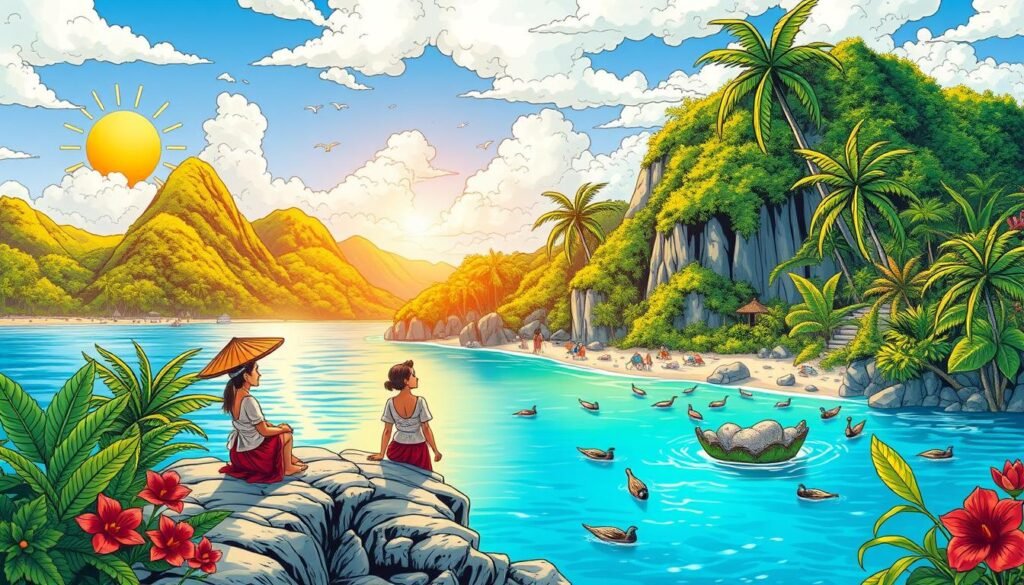
| Climate Type | Description |
|---|---|
| Tropical Rainforest | High temperatures and high humidity throughout the year |
| Tropical Monsoon | Heavy rains during the summer monsoon season |
| Tropical Savanna | High temperatures and low humidity during the dry season |
| Humid Subtropical | Mild temperatures and high humidity throughout the year |
| Oceanic | Mild temperatures and high humidity throughout the year, found in higher-altitude areas |
The Philippines faces typhoons and heavy rainfall, affecting its climate and weather. Knowing these patterns is key for travel and exploring the country’s varied geography and nature.
Biodiversity in the Philippine Archipelago
The Philippines is a treasure trove of unique plants and animals. Many species found here exist nowhere else. The country’s varied geography supports a wide range of biodiversity. About 33 percent of plants in the Philippines are unique, and 75 percent of amphibians are found only here.
The Philippines is a key biodiversity hotspot, with over 700 threatened species. It has the fifth most plant species in the world and 5% of global flora. Nature is vital in the Philippines, with many species depending on its ecosystems.
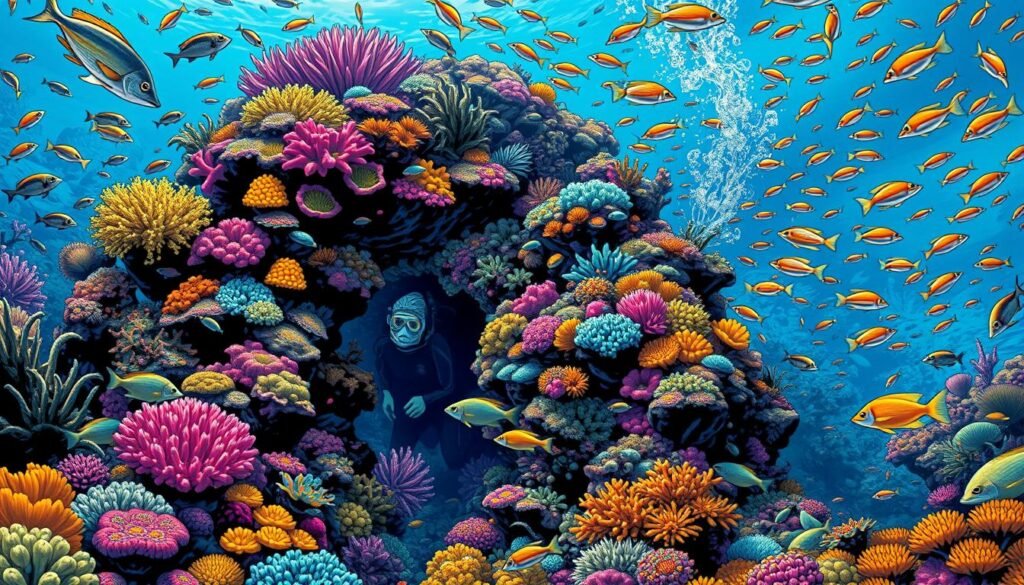
- 60%-70% of the world’s biodiversity is found in the Philippines
- More than 52,177 described species are found in the Philippines, with over half being endemic
- The country hosts 1,238 terrestrial vertebrate species, with 50% being endemic
The Philippines’ unique geography and nature make it perfect for studying biodiversity. Protecting its ecosystems is key to preserving biodiversity in the region.
Cultural Diversity Across the Islands
The Philippines is a mix of cultures, with each island having its own traditions. The country’s indigenous tribes have a rich heritage. Culture shapes the Filipino identity, influenced by Spanish, American, and Asian traditions.
Traveling in the Philippines lets visitors see the country’s diverse culture. They can attend festivals like the Sinulog in Cebu or the MassKara in Bacolod. The Philippines also has historical landmarks like Spanish churches and American schools, showing its rich geography and culture.
Traditional Filipino clothes, like the malong and barong, show the country’s cultural variety. Meals often include rice, meat, fruits, and vegetables. The Philippines is also known for its vibrant arts, including literature, painting, and sculpture.

The Philippines’ mix of diversity and unity comes from ethnic groups blending together. Efforts to keep cultural heritage alive include bilingual education. Groups like the Komisyon sa Wikang Filipino help standardize and promote Philippine dialects.
Economic Significance of the Islands
The Philippines’ islands are a key source of fishing and marine resources. They play a big role in the country’s economy. The islands’ unique geography supports a wide range of ecosystems. This variety of ecosystems is home to many plants and animals.
This natural beauty makes the Philippines a favorite spot for travelers. Visitors love its stunning beaches, lush forests, and vibrant culture.
The country’s nature reserves and protected areas are special. They are home to many unique species. This draws tourists and scientists to the Philippines.
The tourism industry is a big help to the economy. Many people visit to see the natural beauty and rich culture. Some of the main economic benefits of the islands are:
- Fishing and marine resources
- Tourism and travel
- Export of natural products, such as coconuts and pineapples
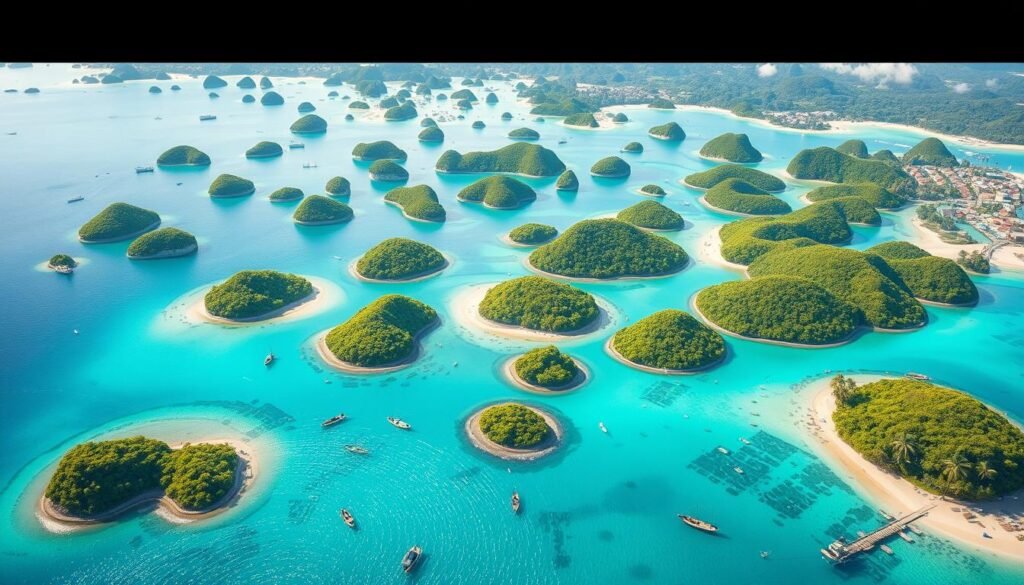
In conclusion, the economic value of the Philippine islands is huge. The country’s unique geography and nature reserves attract travelers. They also help the economy a lot.
| Industry | Contribution to Economy |
|---|---|
| Fishing and Marine Resources | 10% |
| Tourism | 15% |
| Export of Natural Products | 5% |
The Importance of Marine Biodiversity
The Philippines is a key spot for marine biodiversity. Its unique geography supports a wide range of ecosystems. These ecosystems are home to many different plants and animals. Coral reefs in the Philippines are very important. They provide a home for many fish and other sea creatures. To learn more, visit Philippine biodiversity and see why we must protect these areas.
Keeping marine biodiversity healthy is vital for our planet. The Philippines has some of the most diverse marine life in the world. This includes coral reefs, which are key to the ecosystem. Here are some important facts about marine biodiversity in the Philippines:
- Over 300 reef-building corals and more than 1300 fish species inhabit the Red Sea and Gulf of Aden.
- More than 50% of marine biodiversity in the Red Sea and Gulf of Aden are endemic species.
- Conservation efforts focus on creating and effectively managing marine biodiversity areas in the Red Sea and Gulf of Aden.
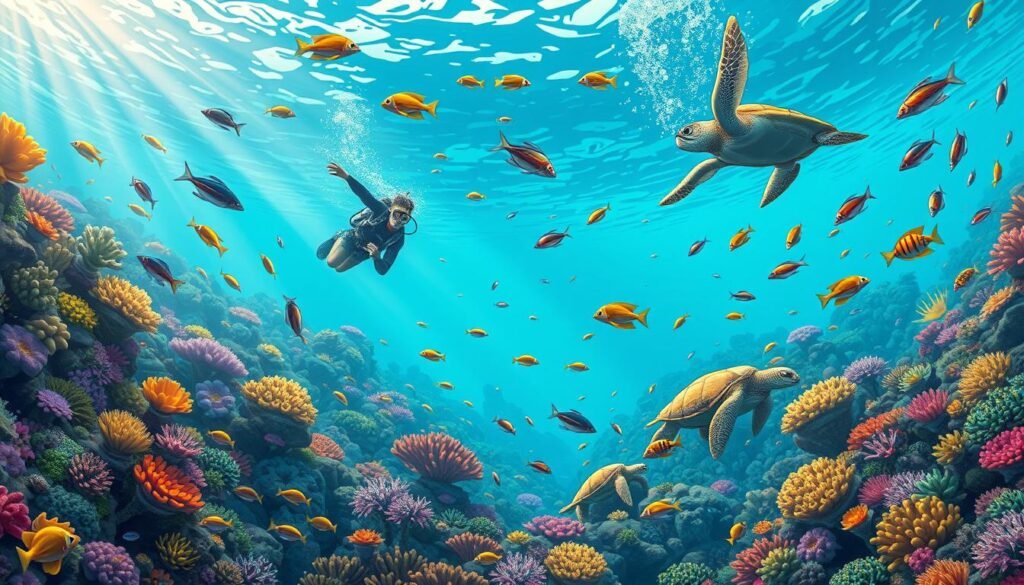
Understanding the value of marine biodiversity and working to save it is key. This way, we can protect the Philippines’ unique geography and nature for the future.
| Location | Number of Species |
|---|---|
| Red Sea and Gulf of Aden | Over 300 reef-building corals and more than 1300 fish species |
| Philippines | Some of the most diverse marine ecosystems in the world |
Historical Influence on Island Formation
The Philippines has a rich history, with Spain colonizing it in the 16th century. This had a big impact on the country’s islands. The Spanish set up settlements and trading posts across the archipelago. The Philippines’ unique geography supports a wide range of ecosystems, home to many plants and animals.
For those who love travel and exploration, the Philippines is a top spot. It boasts beautiful beaches, lush forests, and a vibrant culture. The country’s history and geography have shaped its growth, with Spanish colonization being key. To learn more about this, visit this website for a detailed analysis.
The Philippines’ islands formed from volcanic eruptions and tectonic plate movements. The country is home to diverse flora and fauna, with many species found only here. It’s a great place for travelers, with its unique geography and rich history providing many experiences.
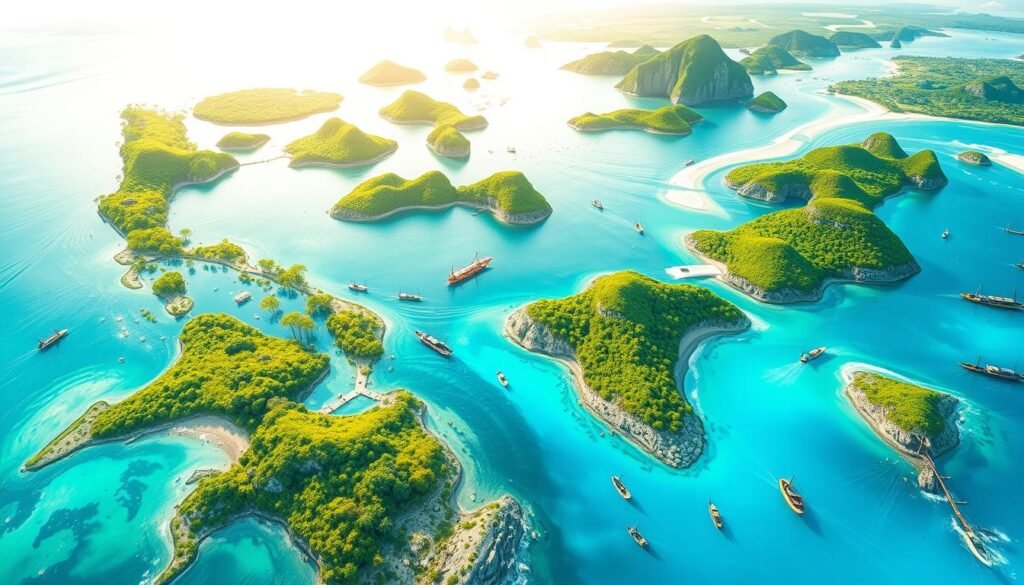
- The arrival of the earliest inhabitants from the Asian mainland approximately 30,000 years ago
- The Spanish colonization period, which began in the 16th century
- The Filipino War of Independence, which started in 1899
- The country’s transition to an independent republic in 1946
| Event | Year |
|---|---|
| Arrival of earliest inhabitants | 30,000 years ago |
| Spanish colonization | 16th century |
| Filipino War of Independence | 1899 |
| Transition to independent republic | 1946 |
Transportation and Accessibility Between Islands
The Philippines faces a big challenge in traveling between islands. Its archipelagic structure means a strong transportation network is needed. A study on island accessibility shows that good transport is key for island communities’ growth.
Key transport links in the Philippines are airports, seaports, and roads. These connect the islands and make travel easier. Yet, challenges remain, mainly in remote spots. The Philippines’ many islands and waters require a reliable transport system.
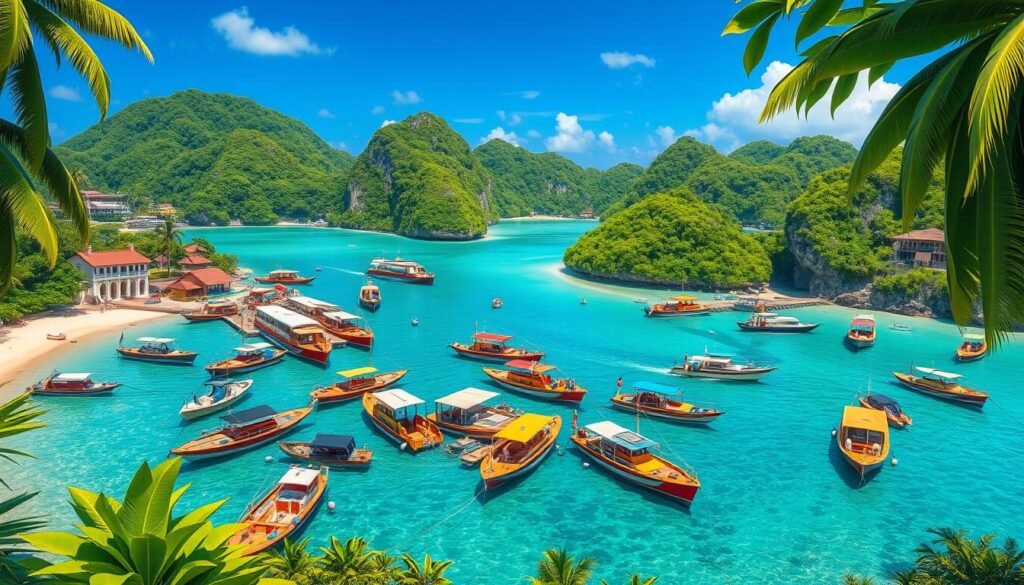
Despite these hurdles, the Philippines is a top travel spot. It boasts stunning beaches, lush forests, and a lively culture. Nature reserves and wildlife sanctuaries draw tourists, making travel a big part of the tourism industry. Understanding the Philippines’ geography and nature helps improve transport and island access.
Environmental Challenges Facing the Archipelago
The Philippines, with its unique geography, is home to many ecosystems. These support a wide variety of plants and animals. But, human actions like deforestation, pollution, and overfishing harm nature and biodiversity.
Some major environmental challenges in the archipelago include:
- Deforestation: The Philippines lost 70% of its forests to just 20% over the 20th century. This has destroyed habitats and biodiversity.
- Pollution: Air pollution in the Philippines causes about 66,000 deaths each year. It shows the urgent need for green practices to protect nature.
- Climate change: Rising sea levels and changes in weather patterns affect geography and ecosystems. This leads to species moving and changes in water availability.
Efforts to save the environment, like creating marine protected areas and promoting eco-tourism, can lessen climate change’s effects. They help keep biodiversity safe in archipelago habitats.
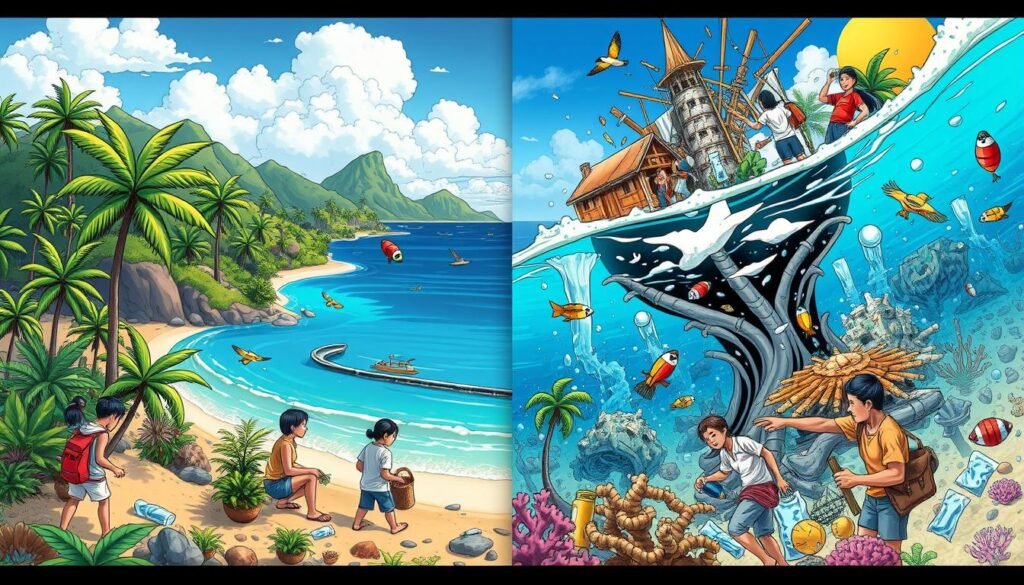
Future Prospects for the Philippines
The Philippines is looking forward to a bright future. It aims to grow its economy and protect its natural beauty. The country is focusing on sustainable development through renewable energy and conservation. This will help keep its unique geography and nature safe.
The tourism sector is also set to expand. The Philippines wants to show off its stunning landscapes and rich culture to more travelers. With over 7,000 islands, it’s a paradise for those who love beaches, forests, and vibrant culture.
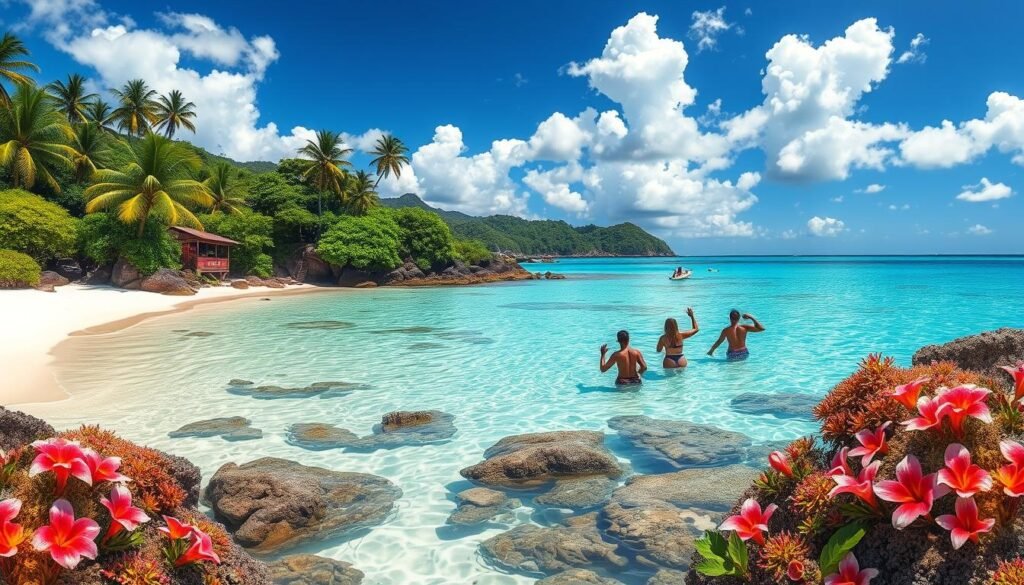
Sustainable Development Initiatives
Initiatives like the Kalahi CIDSS project and the Philippine Rural Development Project are making a big difference. They’ve brought in US$779 million and helped over 1.3 million farmers and fisherfolk. These efforts have boosted the lives of many Filipinos, with a 12% increase in spending among beneficiary households.
Tourism Growth in the Archipelago
The Philippines’ geography and nature make it perfect for travelers. It has beautiful beaches, lush forests, and a lively culture. The government is working to make tourism sustainable, preserving natural resources and cultural heritage.
Conclusion: The Significance of the Philippine Archipelago
The Philippine Archipelago is a unique and diverse place. It shows the country’s special . With over 7,100 islands, each island has its own ecosystems and culture.
The Philippines is in a key spot in Southeast Asia. It has been important in the region’s history and growth. Its beautiful seas, landscapes, and lively people attract visitors worldwide. But, it’s vital to protect this from environmental threats like climate change and pollution.
The Philippines needs to focus on green growth and saving nature. By valuing its and tackling environmental issues, it can keep its beauty for everyone. This way, the Philippine Archipelago will remain a treasure for all who see it.
FAQ
What is the definition of an archipelago?
An archipelago is a group of islands that are clustered together. They often form a chain or a cluster.
What types of archipelagos are there?
There are different types of archipelagos. The Philippines is an oceanic archipelago. It is not connected to a continent.
Where is the Philippine Archipelago located?
The Philippine Archipelago is in Southeast Asia. It has thousands of islands across the western Pacific Ocean. It is bordered by the Philippine Sea, the South China Sea, and the Celebes Sea.
How many islands make up the Philippine Archipelago?
The Philippines has 7,641 islands. It is one of the largest archipelagos in the world. Only about 1,000 islands are populated, with most being small and uninhabited.
How were the islands of the Philippine Archipelago formed?
The Philippine Archipelago was formed by geological processes. These include plate tectonics and volcanic activity. The country’s unique geography supports a wide range of ecosystems and biodiversity.
What is the climate like in the Philippines?
The Philippines has a tropical climate. It has high temperatures and humidity all year. The country is near the equator, so it gets a lot of sunlight.
It is also prone to typhoons and rainfall. These can greatly affect the country’s climate and weather.
What is the biodiversity like in the Philippine Archipelago?
The Philippines is home to a wide range of flora and fauna. It has many endemic species. The country’s unique geography supports a vast array of biodiversity.
How diverse are the cultures across the Philippine islands?
The Philippines has a diverse range of cultures. Each island has its own customs and traditions. The country’s indigenous tribes have a rich heritage.
What is the economic significance of the Philippine islands?
The Philippines’ islands are important for fishing and marine resources. The fishing industry is a big contributor to the economy. Tourism is also a major contributor, with visitors drawn to the country’s natural beauty and rich culture.
What is the importance of marine biodiversity in the Philippines?
The Philippines has some of the most diverse marine ecosystems in the world. Its coral reefs are an important part of the ecosystem. They provide a habitat for many species of fish and other marine life.
The country is also home to many conservation efforts. It works to protect its marine biodiversity.
How has the Philippines’ history influenced its island formation?
The Philippines has a rich history. It was colonized by Spain in the 16th century. The Spanish colonization had a big impact on the country’s island formation.
The Spanish established settlements and trading posts throughout the archipelago.
What challenges does the Philippines face in terms of transportation and accessibility between islands?
The Philippines has a well-developed transportation network. It has many airports, seaports, and roads connecting the islands. But traveling between islands can be challenging.
Many areas are remote and difficult to access.
What environmental challenges is the Philippine Archipelago facing?
The Philippines is facing many environmental challenges. These include climate change, deforestation, and pollution. The country’s natural resources are being threatened by human activities.
What is the future outlook for the Philippine Archipelago?
The Philippines has a bright future. The country is working to develop its economy and protect its natural resources. It is implementing sustainable development initiatives, including renewable energy projects and conservation efforts.
It is also working to grow its tourism industry.
Source Links
- Geography of the Philippines – https://en.wikipedia.org/wiki/Geography_of_the_Philippines
- The Philippines, a living archipelago – https://www.philippinesautrement.com/en/philippines-un-archipel-vivant
- Know before you go: the Philippines – https://www.nationalgeographic.com/travel/article/partner-content-know-before-you-go-the-philippines
- ARCHIPELAGO CONCEPT OF LIMITS OF TERRITORIAL SEAS – https://digital-commons.usnwc.edu/cgi/viewcontent.cgi?article=1854&context=ils
- PDF – https://waqafilmunusantara.com/wp-content/uploads/2023/07/ilovepdf_merged-14-1.pdf
- Philippines – https://kids.nationalgeographic.com/geography/countries/article/philippines
- The Philippines at a Glance – https://www.un.int/philippines/philippines/philippines-glance
- Philippines – https://en.wikipedia.org/wiki/Philippines
- List of islands of the Philippines – https://en.wikipedia.org/wiki/List_of_islands_of_the_Philippines
- From 7,107 to 7,641 – https://opinion.inquirer.net/102845/from-7107-to-7641
- Philippines | History, Map, Flag, Population, Capital, & Facts | Britannica – https://www.britannica.com/place/Philippines
- How Were The Islands In The Philippines Formed? – https://www.worldatlas.com/articles/how-were-the-islands-in-the-philippines-formed.html
- Subduction tectonics of the Philippines – https://en.wikipedia.org/wiki/Subduction_tectonics_of_the_Philippines
- History of the Philippines – https://www.csub.edu/pacificrim/countryprospectus/history.htm
- Climate of the Philippines – https://en.wikipedia.org/wiki/Climate_of_the_Philippines
- PDF – https://www.climatelinks.org/sites/default/files/asset/document/philippines_climate_vulnerability_profile_jan2013.pdf
- Philippine Biodiversity | Expeditions – https://expeditions.fieldmuseum.org/island-mammals/philippine-biodiversity
- Main Details – https://www.cbd.int/countries/profile/?country=ph
- Biodiversity Philippine Clearing House Mechanism – http://www.philchm.ph/status-of-philippine-biodiversity-2/
- Discovering Diversity: A Journey through Philippine Dialects – https://medium.com/@nipinodotcom/discovering-diversity-a-journey-through-philippine-dialects-d0c041e191e3
- Philippines – Culture, Diversity, Traditions | Britannica – https://www.britannica.com/place/Philippines/Cultural-life
- The Significance of Indonesia’s Hosting of the Archipelago and Island States Forum – https://thediplomat.com/2023/11/the-significance-of-indonesias-hosting-of-the-archipelago-and-island-states-forum/
- Extremes in the Archipelago: Trade and Economic Development in the … – https://journals.openedition.org/moussons/2639
- Marine Biodiversity – Archipelagos – https://archipelago.gr/fields-of-action/marine-biodiversity/
- Marine Biodiversity – Persga – https://persga.org/programmes/marine-biodiversity/
- Areas of Research – UP Marine Science Institute – https://msi.upd.edu.ph/research/areas-of-research/
- Island – https://education.nationalgeographic.org/resource/island/
- The age and origin of the Pacific islands: a geological overview – https://pmc.ncbi.nlm.nih.gov/articles/PMC2607379/
- PDF – https://www.irjes.com/Papers/vol2-issue9/C02091218.pdf
- Journal of Marine and Island Cultures — v9n2 – https://jmic.online/issues/v9n2/4/
- The Potential of Disruptive Transport Infrastructure for Tourism Development in Emerging Island Destinations: Research Project in the Faroe Islands | Published in Island Studies Journal – https://islandstudiesjournal.org/article/81195-the-potential-of-disruptive-transport-infrastructure-for-tourism-development-in-emerging-island-destinations-research-project-in-the-faroe-islands
- Environmental issues in the Philippines – https://en.wikipedia.org/wiki/Environmental_issues_in_the_Philippines
- The Archipelago of Hope: Wisdom and Resilience from the Edge of Climate Change – https://www.adaptation-undp.org/resources/archipelago-hope-wisdom-and-resilience-edge-climate-change
- Climate Change: Impact on Archipelago Habitats and Ecosystems – FasterCapital – https://fastercapital.com/content/Climate-Change–Impact-on-Archipelago-Habitats-and-Ecosystems.html
- Overview – https://www.worldbank.org/en/country/philippines/overview
- The Philippines: Rising Star in the Global Innovation Economy – https://hortoninternational.com/the-philippines-a-rising-star-in-the-global-innovation-economy/
- About the Philippines – SEIPI – https://seipi.org.ph/about-the-philippines/
- PDF – https://dhsprogram.com/pubs/pdf/fr01/01chapter01.pdf
- DFA-MANAMo 2022 – The Archipelagic Doctrine – https://sites.google.com/dfa.gov.ph/dfa-manamo22/the-archipelagic-doctrine

